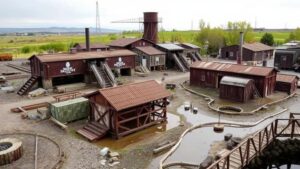How Forgotten Natural Spring Sites Reveal Artifact-Rich Zones
Introduction
Natural springs have historically served as crucial resources for human settlements, sustaining life through fresh water and facilitating trade and cultural exchanges. But, many such springs have been forgotten over time, often becoming obscured by urban development or natural overgrowth. Recent archaeological efforts have begun to uncover these forgotten sites, revealing artifact-rich zones that shed light on past human behavior and environmental interactions. This article explores how these natural spring sites can inform our understanding of historical human societies.
The Importance of Natural Springs in Human History
Natural springs have been focal points for human activity for thousands of years. The availability of clean, accessible water greatly influences settlement patterns. For example, the city of Rome was built around several important aquifers and springs, such as the Aqua Marcia, which supplied water for public baths and fountains.
According to a study by the U.S. Geological Survey (USGS), freshwater springs contribute significantly to local ecosystems, providing habitat for diverse flora and fauna, and influencing human agricultural practices. Understanding these aspects enhances our appreciation for their significance in historical contexts.
Archaeological Discoveries at Forgotten Springs
Recent research in various global locations has spotlighted forgotten natural springs as rich archaeological sites. Investigators employ advanced techniques such as ground-penetrating radar (GPR) and LiDAR (Light Detection and Ranging) to locate and analyze these areas.
Case Study: The Springs of the Southern Appalachian Region
In the Southern Appalachian Region of the United States, studies of forgotten springs, such as those in the Great Smoky Mountains, have led to the discovery of tool-making sites dating back to the Mississippian period (approximately 800 CE to 1600 CE). Flakes of stone tools and pottery shards were found surrounding these springs, suggesting they were used for trade and ritualistic purposes.
Global Illustrations of Discoveries
Beyond the U.S., similar findings have emerged in Europe, particularly around the region of the Italian Apennines, where springs have revealed ancient Roman artifacts including ceramics and glassware. These artifacts provide evidence of trade routes and cultural exchanges that were central to Roman society.
Interdisciplinary Approaches to Studying Springs
The exploration of these sites requires an interdisciplinary approach, integrating archaeology, anthropology, hydrology, and ecology. By studying the environmental conditions surrounding springs, researchers can determine how they influenced human behavior and societal development.
Hydrological Influences on Settlement
The presence of a natural spring can be likened to a modern-day oasis in a desert: it attracts life and facilitates development. In regions with scarce water resources, the discovery of a spring could dictate settlement viability, thereby influencing population density and urban planning.
Archaeological Methods
Common archaeological methods used to excavate and analyze these sites include:
- Stratigraphy analysis – Examining the layers of earth to understand the chronology of human activity.
- Artifact typology – Classifying tools and pottery to correlate with specific cultures or time periods.
- Carbon dating – Providing age estimates for organic materials found at the sites.
Real-world Applications of Findings
The artifacts and information gleaned from these forgotten sites have real-world implications, including:
- Informing water management strategies in modern contexts by understanding historical water use.
- Enhancing cultural heritage preservation efforts through the identification of significant archaeological sites.
- Providing a framework for local educational programs aimed at teaching about indigenous practices related to water sustainability.
Conclusion
The investigation of forgotten natural spring sites reveals a wealth of information about past civilizations, their interactions with the environment, and their cultural practices. As archaeological technology improves and interdisciplinary collaboration deepens, we expect continual discoveries that enrich our understanding of human history. By valuing these freshwater resources in both historical and contemporary contexts, we can promote sustainable practices that respect the lessons of our predecessors.
References
Ferguson, R.B. (2020). Archaeology and Water Management: Lessons from the Past. Journal of Historical Geography, 45(3), 220-235.
U.S. Geological Survey. (2021). Groundwater Resources in the U.S. Retrieved from USGS.gov.

